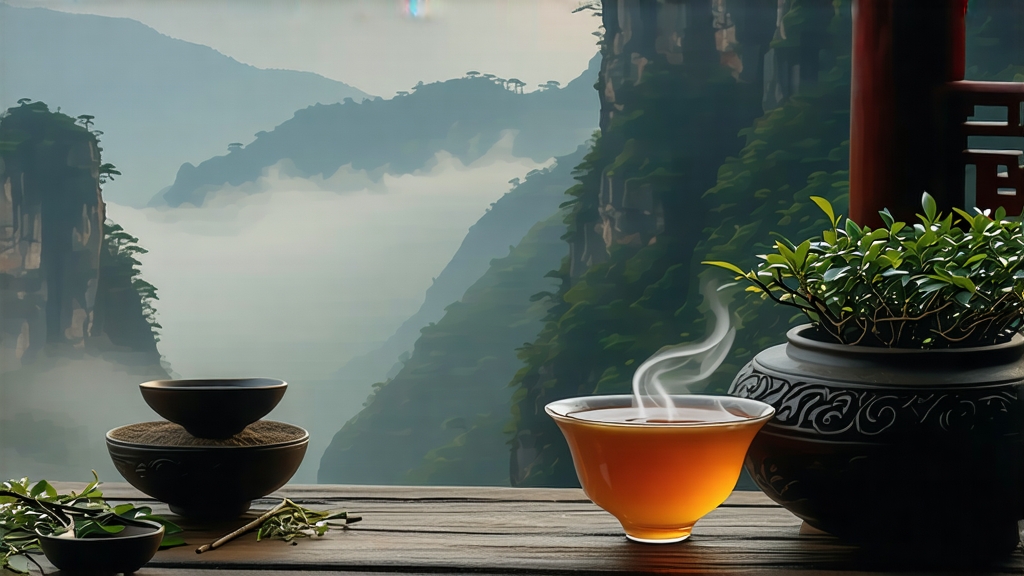
High in the Wuyi Mountains of northern Fujian, where mist coils around knife-sharp cliffs and a slow, mineral-rich river gnaws at granite boulders, grows the most storied of all Chinese oolongs—Da Hong Pao, literally “Big Red Robe.” To the Chinese palate its name evokes not only a flavor but an entire landscape: the taste of roasted stone, orchid nectar, and camphor smoke carried on a cool gorge wind. To the international tea traveler it is often the first “rock tea” (yancha) ever sampled, yet its depths can take decades to explore. This essay invites you into those depths, tracing the legend, botany, craft, and cupping ritual that have made Da Hong Pao the king of oolong for over three centuries.
-
Legend and Historical Footprints
The romantic origin most frequently retold begins in the early Ming dynasty. A passing imperial scholar, overcome with fever, was revived by monks who brewed leaves picked from four scraggly bushes clinging to a crevice outside Jiulongke (“Nine-Dragon Cave”). Grateful, the scholar draped his imperial crimson robe over the bushes before continuing to the capital, where he later sent a red silk canopy to protect the plants from mountain frost. Whether apocryphal or not, the tale cemented the name and sanctity of Da Hong Pao. By the late Qing the tea was tribute-grade; court records from 1725 list “Wuyi red-robe” among gifts to the Kangxi Emperor. In 1985 cuttings from the original mother trees—still alive today inside a guarded nature reserve—were successfully propagated, giving rise to the modern “purebred” or qizhong Da Hong Pao that most connoisseurs now drink. -
Micro-terroir: Why “Rock Rhyme” Matters
Wuyi’s Danxia landform creates a stress environment ideal for tea: shallow, gravelly topsoil packed with eroded granite and quartz, sharp diurnal swings of 15 °C, and a constant film of mist that filters sunlight into soft, diffused rays. The result is slow growth, small leaf cells, and a high concentration of aromatic volatiles. Locals speak of yanyun—“rock rhyme”—a tactile minerality that manifests as a cool, tingling sensation on the lateral edges of the tongue, reminiscent of wet slate or river pebbles. Only teas grown inside the 60 km² core scenic reserve may legally bear the Wuyi yancha designation; everything else is “Wuyi-style” grown in lower elevations or neighboring counties. -
Botanical Lineage and Commercial Grades
Da Hong Pao is a collective name that now encompasses three distinct market tiers:
a) Mother-Tree Da Hong Pao—harvesting from the original six bushes has been banned since 2006, so any claim of “authentic mother-tree leaf” is either pre-2006 stock (less than 200 g remain in private hands) or marketing fiction.
b) Purebred Qizong—clonal offspring of the mother trees, cultivated from cuttings and grown inside the reserve. Leaf shape is stubby and thick, with a distinctive sand-green hue flecked by iron-oxide red.
c) Blended Da Hong Pao—skillful marriages of several Wuyi cultivars (often Rou Gui, Shui Xian, and Tie Luo Han) designed to mimic the fragrance–body balance of the original. High-grade blends can outperform mediocre purebreds, so pedigree alone does not guarantee cup quality. -
Craft: The Eight-Stage Choreography
Rock oolong is the most labor-intensive tea in China, requiring eight precise steps traditionally timed by the mountain’s own light and humidity cues.
Step 1: Plucking—Only the middle 3–4 leaves are taken once the spring mountain temp stabilizes at 20 °C, usually between May 5–15. Pickers work from 7 a.m. to 11 a.m. before gorge winds rise and dehydrate the leaf edges.
Step 2: Wilting—Leaves are spread on bamboo sieves set on racks inside a shaded corridor; ambient mountain breeze reduces moisture by 10 % in 1.5–2 hours, priming the leaf for mechanical bruising.
Step 3: Shaking—The “green work” (zuoqing) begins at dusk. Forty-pound batches